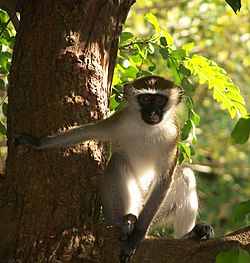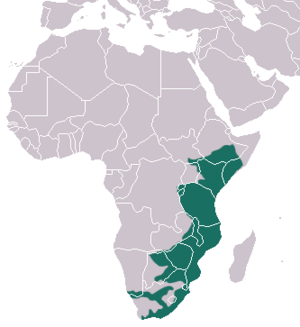Vervet monkey facts for kids
Quick facts for kids Vervet monkey |
|
|---|---|
 |
|
| Vervet monkey in Dar es Salaam, Tanzania | |
| Conservation status | |
| Scientific classification | |
| Kingdom: | |
| Class: | |
| Order: | |
| Family: | |
| Genus: |
Chlorocebus
|
| Binomial name | |
| Chlorocebus pygerythrus |
|
 |
|
| Vervet monkey range | |
The vervet monkey (Chlorocebus pygerythrus), or simply vervet, is a type of Old World monkey. These monkeys are originally from Africa. The name "vervet" can also mean any monkey in the Chlorocebus group. You can find them mostly in Southern Africa and some eastern African countries.
Vervets were also brought to the Americas, where there were no Old World monkeys before. Now, you can find them in places like Florida, Texas, Alabama, Louisiana, Arizona, California, Ascension Island, Cape Verde, Barbados, Saint Kitts, Bermuda, Bahamas, Cuba, Jamaica, Haiti, Dominican Republic, and Nevis.
Vervet monkeys mostly eat plants. They have black faces and grey fur. Males are about 50 centimeters long, and females are about 40 centimeters long.
Contents
About Vervet Monkeys
Vervet monkeys are interesting animals that help scientists learn about human behavior. They show some traits that are similar to humans, like having hypertension (high blood pressure) and anxiety.
Social Life of Vervets
Vervets live in social groups. These groups can have anywhere from 10 to 70 monkeys. When male vervets become adults, they usually move to a different group. This helps keep the groups healthy and diverse.
How Vervets Communicate
One of the most important things scientists study about vervet monkeys is how they communicate. They use special sounds called alarm calls. These calls help them recognize their family and other monkeys in their group. They also use these calls to warn each other about dangers, like predators. Different alarm calls can even mean different types of predators, like a snake or an eagle!
Images for kids
-
Female and juvenile, Kruger Park, South Africa
-
Young vervet monkey in South Africa eating fruits of Harpephyllum caffrum
See also
 In Spanish: Cercopiteco verde para niños
In Spanish: Cercopiteco verde para niños










